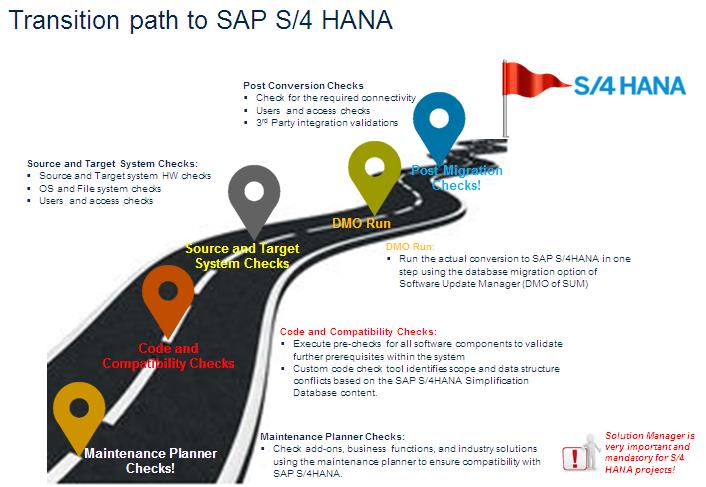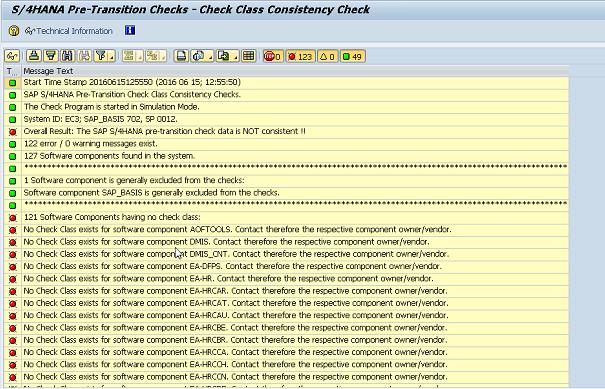
- SAP Community
- Products and Technology
- Enterprise Resource Planning
- ERP Blogs by Members
- S/4HANA Conversion 2nd Step – Code and Compatibili...
- Subscribe to RSS Feed
- Mark as New
- Mark as Read
- Bookmark
- Subscribe
- Printer Friendly Page
- Report Inappropriate Content
Introduction
As discussed in previous blog the digital transformation path for S/4HANA has various steps and it’s very important to validate and pass thru each step of the road map to achieve the successful S/4 conversion project.
Just a recap to earlier blogs, in previous blog of S/4HANA - Path to Digital Transformation we learnt about what all options to adopt the S/4HANA and started discussing about the option of system conversion.
Note: As discussed earlier, the system conversion option is available for such customer who wants to convert their current system into an SAP S/4HANA system
Below is the high level plan for the S/4HANA conversion program, we already covered the 1st step in the blog How to use Maintenance Planner for S/4HANA Conversion.

The 2nd step in the road map is to do the code and compatibility check.
The code and compatibility check has three sub tasks which are important from the conversion perspective
- Review the simplification list for SAP S/4HANA
- SAP S/4HANA conversion pre-checks
- Custom code analysis
Simplification List review
The simplification list for SAP S/4HANA is useful for the customers to understand the functional level details with S/4HANA and changes to the individual transactions, applications and solutions. Few of the functionality are combined, few of the functionality are made obsolete and some equivalent functionality is enabled with S/4HANA, some cases there is enhancement to the existing functionality.
The list is available with the required changes in PDF and XLS format for customer reviews for better planning and estimation for the S/4HANA conversion programs

The Simplification List is integrated with the custom code check tool. This tool provides a detailed report about where the custom code on your SAP Business Suite system does not comply with the scope and data structures of SAP S/4HANA
Note: The involvement of functional and technical team is very important in this phase of activities
The next step is the system pre-checks
Pre-checks are important to identify the required steps and make sure the system is compatible for the conversion process
The pre-checks are very important and should be completed before starting the next phase of activities and running the SUM tool. The output of pre-checks is the list of items which needs to be addressed before the actual conversion process is started.
Basically pre-check is ran twice on the overall process, first time as manual pre-check and second time during SUM execution. If there are errors in pre-check phase in SUM tool then the SUM tool will stop and conversion is aborted, due to this it is very important to run the pre-check as manual run ahead of time.
Note: It’s very important and mandatory to run maintenance planner before starting pre-checks phase. Please refer blog How to use Maintenance Planner for S/4HANA Conversion on how to run maintenance planner
Pre-check process
During the pre-check phase it’s important to implement the SAP note 2182725 and related notes in all the source systems which are in scope for the conversion (The note needs to be implemented in Sandbox, Dev, QA, Prod and any other systems which is part of conversion project)
The SAP notes contains a report, “R_S4_PRE_TRANSITION_CHECKS” which needs to be run manually in the source system to do the pre-check activity
Best Practices to follow for running the pre-checks:
- Make sure the manual activities as per SAP note 2182725 are completed. Import all the notes which are mentioned as part of manual activities
- Follow the sequence of runs for the report “R_S4_PRE_TRANSITION_CHECKS”
- Make sure to run the report in Simulation Mode (P_Test) mode
- All the errors which are reported as part of Check Class Consistency Check option should be fixed before you run the Pre-Transition Check Option
- Make sure to run the maintenance planner and have stack xml downloaded and kept at server level


In order to address all the pre-check errors you need to review various SAP notes and raise OSS message with SAP with individual components. For some of the issues, you need to upgrade individual components to certain supported version.
e.g: The ECC DIMP component needs to have minimum release 999 SP 99. Check the below SAP note
2310116 - Report R_S4_PRE_TRANSITION_CHECKS return errors on ECC-DIMP
The overall check result return code must be lower or equal to 4. Otherwise the Software Update Manager (SUM) will not be able to perform the conversion of your system.
Note: The involvement of Basis, ABAP technical and functional team is very important in this phase of activities
The next step in the conversion process is to do the custom code analysis
Custom Code Analysis
For the SAP system conversion to SAP S/4HANA, any modification/simplifications made to SAP objects need to be considered in your customer objects.
The Custom Code Migration work list helps to provide the details of all customer objects and provide the reference to simplified SAP objects and links to information about how to adopt these customer objects.
Few of the pre-requisite and requirement for custom code analysis:
- The source system version should be NW 7.0 to 7.40 which is called as SAP business suite system during conversion process
- Only ABAP stack with Unicode system
- To setup the custom code migration work list, you need to have separate NW 7.5 system against which the custom code analysis will be performed. This system is called as evaluation system
- To save some cost and time, you can utilize the evaluation system from SAP Cloud Appliance Library (CAL) hosted on AWS cloud as this is the temporary setup
- You have completed the maintenance planner tasks and pre-check tasks mentioned above
Please refer the below setup diagram which shows the required setup to run the custom code work list for migration

The custom code analysis is basically set of activities which need to perform with proper pre-requisites and sequence; at high level below are the steps which are explained in detail in the blog Custom Code Analysis Setup
Below are the high level steps for the custom Code Analysis Setup
- Evaluation System Implementation: Implement the NW 7.5 ABAP stack
- To save some cost and time, you can utilize the evaluation system from SAP Cloud Appliance Library (CAL) hosted on AWS cloud as this is the temporary setup
- Download and Import Simplification database list into evaluation system
- Implement SAP note 2185390: Custom Code Analyzer tool
- Download and Import Custom Code Analyzer list from source system
- Compare the custom code analyzer results against the simplification DB
- Adapt the simplification items for diff applications
Note: In this exercise the ABAP development/technical team along with Basis team plays very critical role.
This is the 2nd step in your S/4HANA conversion project.
With this we have completed the S/4HANA Conversion – Code and Compatibility Check
The next step in the S/4HANA conversion road map is Source and Target System Checks
Reference Links:
http://scn.sap.com/docs/DOC-68976
- SAP Managed Tags:
- SAP S/4HANA
You must be a registered user to add a comment. If you've already registered, sign in. Otherwise, register and sign in.
-
"mm02"
1 -
A_PurchaseOrderItem additional fields
1 -
ABAP
1 -
ABAP Extensibility
1 -
ACCOSTRATE
1 -
ACDOCP
1 -
Adding your country in SPRO - Project Administration
1 -
Advance Return Management
1 -
AI and RPA in SAP Upgrades
1 -
Approval Workflows
1 -
ARM
1 -
ASN
1 -
Asset Management
1 -
Associations in CDS Views
1 -
auditlog
1 -
Authorization
1 -
Availability date
1 -
Azure Center for SAP Solutions
1 -
AzureSentinel
2 -
Bank
1 -
BAPI_SALESORDER_CREATEFROMDAT2
1 -
BRF+
1 -
BRFPLUS
1 -
Bundled Cloud Services
1 -
business participation
1 -
Business Processes
1 -
CAPM
1 -
Carbon
1 -
Cental Finance
1 -
CFIN
1 -
CFIN Document Splitting
1 -
Cloud ALM
1 -
Cloud Integration
1 -
condition contract management
1 -
Connection - The default connection string cannot be used.
1 -
Custom Table Creation
1 -
Customer Screen in Production Order
1 -
Data Quality Management
1 -
Date required
1 -
Decisions
1 -
desafios4hana
1 -
Developing with SAP Integration Suite
1 -
Direct Outbound Delivery
1 -
DMOVE2S4
1 -
EAM
1 -
EDI
2 -
EDI 850
1 -
EDI 856
1 -
EHS Product Structure
1 -
Emergency Access Management
1 -
Energy
1 -
EPC
1 -
Find
1 -
FINSSKF
1 -
Fiori
1 -
Flexible Workflow
1 -
Gas
1 -
Gen AI enabled SAP Upgrades
1 -
General
1 -
generate_xlsx_file
1 -
Getting Started
1 -
HomogeneousDMO
1 -
IDOC
2 -
Integration
1 -
Learning Content
2 -
LogicApps
2 -
low touchproject
1 -
Maintenance
1 -
management
1 -
Material creation
1 -
Material Management
1 -
MD04
1 -
MD61
1 -
methodology
1 -
Microsoft
2 -
MicrosoftSentinel
2 -
Migration
1 -
MRP
1 -
MS Teams
2 -
MT940
1 -
Newcomer
1 -
Notifications
1 -
Oil
1 -
open connectors
1 -
Order Change Log
1 -
ORDERS
2 -
OSS Note 390635
1 -
outbound delivery
1 -
outsourcing
1 -
PCE
1 -
Permit to Work
1 -
PIR Consumption Mode
1 -
PIR's
1 -
PIRs
1 -
PIRs Consumption
1 -
PIRs Reduction
1 -
Plan Independent Requirement
1 -
Premium Plus
1 -
pricing
1 -
Primavera P6
1 -
Process Excellence
1 -
Process Management
1 -
Process Order Change Log
1 -
Process purchase requisitions
1 -
Product Information
1 -
Production Order Change Log
1 -
Purchase requisition
1 -
Purchasing Lead Time
1 -
Redwood for SAP Job execution Setup
1 -
RISE with SAP
1 -
RisewithSAP
1 -
Rizing
1 -
S4 Cost Center Planning
1 -
S4 HANA
1 -
S4HANA
3 -
Sales and Distribution
1 -
Sales Commission
1 -
sales order
1 -
SAP
2 -
SAP Best Practices
1 -
SAP Build
1 -
SAP Build apps
1 -
SAP Cloud ALM
1 -
SAP Data Quality Management
1 -
SAP Maintenance resource scheduling
2 -
SAP Note 390635
1 -
SAP S4HANA
2 -
SAP S4HANA Cloud private edition
1 -
SAP Upgrade Automation
1 -
SAP WCM
1 -
SAP Work Clearance Management
1 -
Schedule Agreement
1 -
SDM
1 -
security
2 -
Settlement Management
1 -
soar
2 -
SSIS
1 -
SU01
1 -
SUM2.0SP17
1 -
SUMDMO
1 -
Teams
2 -
User Administration
1 -
User Participation
1 -
Utilities
1 -
va01
1 -
vendor
1 -
vl01n
1 -
vl02n
1 -
WCM
1 -
X12 850
1 -
xlsx_file_abap
1 -
YTD|MTD|QTD in CDs views using Date Function
1
- « Previous
- Next »
- SAP ERP Functionality for EDI Processing: UoMs Determination for Inbound Orders in Enterprise Resource Planning Blogs by Members
- Advanced WIP reporting in S/4HANA Cloud Public Edition in Enterprise Resource Planning Blogs by SAP
- need suggetion for upgrade HANA version in Enterprise Resource Planning Q&A
- SAP S/4HANA Cloud Private Edition | 2023 FPS01 Release – Part 1 in Enterprise Resource Planning Blogs by SAP
- Compatibility of the 3rd addon XFT version cannot determine to selected S4HANA release. in Enterprise Resource Planning Q&A
| User | Count |
|---|---|
| 2 | |
| 2 | |
| 2 | |
| 2 | |
| 2 | |
| 2 | |
| 2 | |
| 2 | |
| 1 | |
| 1 |